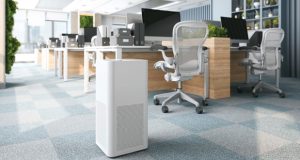 WORKPLACE SOLUTION PROVIDER’S VIEW
WORKPLACE SOLUTION PROVIDER’S VIEWANGELA LOVE
DIRECTOR, ACTIVE WORKPLACE SOLUTIONS
In March 2020, millions of people were suddenly forced to work from home. For many, they grabbed a notebook, a pen, their laptop and charger, and assumed it would be for a few weeks. They coped with the strange circumstances, setting up temporary workspaces at dining tables, perched on sofas and for some, propped up in bed. Those emergency solutions, that didn’t account for ergonomic wellbeing in the short-term, are a lot less suitable now that working from home has become more long-term than we ever expected.
There is no blame on employers for overlooking health and safety considerations, especially given the speed at which homeworking became the norm. The pandemic has thrown up a host of challenges and it’s been difficult for employers to keep up with the wellbeing needs of their teams. That said, it is important to recognise that the employer is responsible for the protection of the occupational health and safety of their employees.
Under the Health and Safety at Work Act 1974, employers are responsible for carrying out risk assessments on all of the work activities carried out by their employees – including homeworkers. The current circumstances mean that it’s not realistic for a full risk assessment to happen in every employee’s home, but that doesn’t absolve employers of responsibility.
At a minimum, employers should be providing homeworkers with information on how to work safely in their home environment. This could include advice on taking regular screen-breaks, stepping away from their workstations or recommending stretching exercises. It should also involve asking employees to carry out a self-assessment of their workspace and equipment or provide them with guidance on how to do this correctly. If issues are identified through that process, employers are responsible for making sure they are rectified and that employees can work at home in a safe and healthy way.
This could mean providing employees with office equipment to use at home – anything from a mouse, a standalone keyboard and wrist supporting mats, to a good office chair, a separate monitor or cushions to provide lumbar support. There are lots of flexible options available, like foldaway desks and chairs, so employers can still provide the necessary support where an employees’ space at home is limited. The key is to ensure that all employees have the right equipment to be able to work safely from home, and that employers make the same effort as they would for office-based employees to reduce the risk of musculoskeletal disorders.
We have seen much discourse that suggests one of the lasting effects of the pandemic will be an increase in homeworking in the future. Taking steps to understand and manage ergonomics in the home now is likely to deliver longer-term value.
 ERGONOMIC EQUIPMENT PROVIDER’S VIEW
ERGONOMIC EQUIPMENT PROVIDER’S VIEW
SAM RYLANDS
MARKETING MANAGER, DURABLE UK
One of the biggest challenges of the pandemic for many of us has been adapting to working from home. Whilst some workers have been embracing the concept for years, the majority of UK workers don’t have a dedicated office space or desk in their homes and have therefore found themselves perched on the end of the kitchen table with the kids running round them, or worse, craned over their laptop from their sofa or bed.
Deep down, most home workers know that by working from the sofa or bed, their posture is suffering, but do they truly appreciate the impact of this on their long-term health?
The Institute of Employment Studies Home Wellbeing Survey reported that, in the first lockdown in the UK, 58 per cent of people complained of new neck pain, 56 per cent of new shoulder pain and 55 per cent of new back pain. The scary fact is that now, in lockdown three, with the cold weather and general lockdown fatigue setting in, these poor habits are only likely to have gotten worse.
For businesses the impact of this on resources can be severe. In 2019/20, a staggering 8.8 million work days were lost in the UK due to musculoskeletal disorders, costing employers over £300 million.
FM’s can therefore play a vital role in protecting both the wellbeing of their businesses and colleagues by facilitating suitable home working processes which minimise the health risks. There are two key parts to this:
- Advising their colleagues on the correct ways to set up their working area, by applying the DSE assessment concept and ensuring that this is clearly explained and followed
- Providing products and solutions to support good home working practices
Adapting the DSE assessment should be relatively routine for most FMs and suggesting ergonomic monitor mounts and chairs may be obvious solutions, but here are three areas you may not have considered.
Lighting is an often overlooked element of home working, but poor lighting affects our eyesight, sleep and cognitive performance. Most homes aren’t wired (pardon the pun) to have the same levels of lighting as an office, which has a minimum legal requirement of 500 lux for detailed work.
Staff should be advised to set up the working area side-on to a window to get as much natural light as possible and aim lights at the workspace to avoid glare on the screen and illuminate the entire working area. Time saving and organisational products are also useful to recommend to staff, many of which will complement their home décor, which will aid their productivity and help them maintain their work-life balance.
Colourful table top Drawer Boxes help to keeps all files and desk equipment in one place and are perfect for fitting into any home office set up because they are light and compact.
Most home workers are sharing their ‘office spaces’ with children and pets, so providing cable management helps them to tidy the hundreds of trailing cables they now have in their living room from their work equipment. This reduces the impact on their home lives and therefore encourages home workers to leave their home office working area ‘set up’ at all times, decreasing the urge to WFB.




